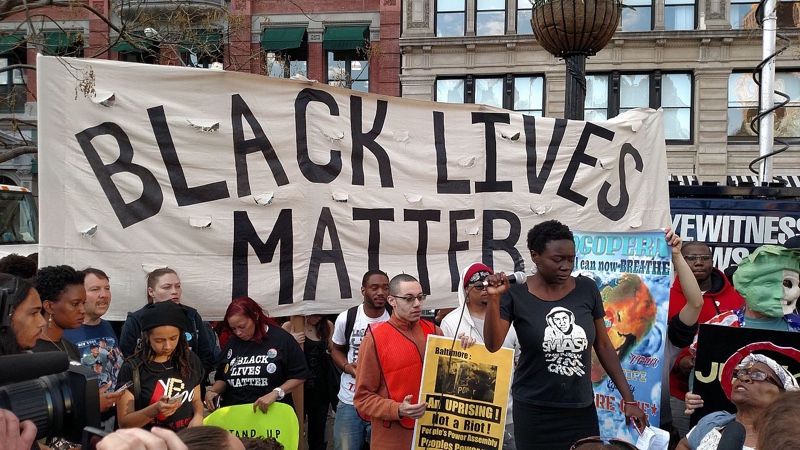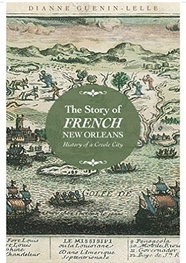The History of Race in America Is Not Black and White

"NYC Rise Up and -ShutItDown for Baltimore (17291634126)" by The All-Nite Images from NY, NY, USA - NYC Rise Up and #ShutItDown for Baltimore. Licensed under CC BY-SA 2.0 via Commons.
Despite the racial divide in this country, exemplified by the #blacklivesmatter movement, history shows it does not have to be this way. If we are going to fill this chasm, we should look to the past. A past that we have forgotten too often.
Our accepted version of US history is basically that African Americans came to this land to become enslaved by whites and were liberated by the Emancipation Proclamation. While there existed Free People of Color before the Civil War, in this version of history, they managed to escape slavery and move north. This narrative sets up race relations along a “black-white” color line of racial separation, and accompanying opposition around questions of privilege, power and dignity. In the US today many feel a sense of despair that the situation has changed so little over so long, and a kind of hopeless fear that things might never be different.
 The
black/white divide does not tell our whole story as a nation. In the
antebellum south, there existed the most accomplished society of Free
People of Color in America. They were writers, teachers, social
activists, and business owners. Some were abolitionists, while others
owned slaves. They lived and worked in what we would call today the
first “integrated neighborhood” in this country: The New Orleans
French Quarter.
The
black/white divide does not tell our whole story as a nation. In the
antebellum south, there existed the most accomplished society of Free
People of Color in America. They were writers, teachers, social
activists, and business owners. Some were abolitionists, while others
owned slaves. They lived and worked in what we would call today the
first “integrated neighborhood” in this country: The New Orleans
French Quarter.
Earliest families of the founding generation were racially mixed. They spoke French and Creole, rather than English, practiced Catholicism and Voudou, rather than Protestantism, and thanks to the Louisiana Purchase in 1803, the members of this community became citizens of the United States. They defined community by language and religion rather than along the black-white binary. Social tensions certainly existed in this society, but not along the same color line that we have come to accept as our norm. It was only in later generations that a white elite emerged.
If we look to the earliest works of African-American literature, as well as the first newspapers and literary journals written or owned by blacks, we see abundant examples of collaboration as well as forms of protest and calls for the abolition of slavery. Victor Séjour’s short story, The Mulatto (Le Mulâtre) published in 1837 represents the earliest work of African American fiction. It stands as a seething social critic of the inhumanity of slavery, from the perspective of a mixed-race offspring.
Predating Frederick Douglass, newspapers such as L’Abeille (The Bee), founded in the 1820s and published for nearly a century, printed pieces on progressive issues and included articles by Free People of Color. In the 1860s L’Union and later La Tribune de la Nouvelle-Orléans were anti-slavery newspapers notably owned and edited by people of color. These writers continued to write in spite of the growing racial oppression before the Civil War and politics of growing segregation after it.
In New Orleans, the history of protest by People of Color culminated in the 1890s when activists from the Comité des Citoyens (The Citizens’ Committee) challenged the growing segregation and Jim Crow laws in the south established under the Supreme Court ruling, Plessy vs Ferguson. Like Rosa Parks on the bus in Montgomery who refused to move, Homer Plessy boarded the whites’ only railroad car in New Orleans. The difference being that the Committee staged the event for maximum press. Although Plessy and People of Color lost the case, it stood as the legal springboard for the Brown vs Board of Education decision.
The encroaching racism in New Orleans gave People of Color few options: to pass for white, to leave the city for the more isolated rural areas of Louisiana, or to remain in their hometown and have much of their privilege, power and dignity taken from them.
The black-white divide became the New Orleans’ story, but it did not start that way. The change coincided with this French-speaking Creole population’s assimilation into Anglo-America. The early history of New Orleans represents only one exception to received notions of American history. If we seek out more examples in our historical record that do not fit our received notions of who we are and what we have been as Americans, we might be able to have new ways to chart a collective path forward. By understanding our earliest histories, often ignored, we will understand how the real foundations of this country are not as simple as we might have thought, not black and white.